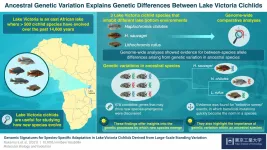(Press-News.org) CORVALLIS, Ore. - Socially just policies aimed at limiting the Earth's human population hold tremendous potential for advancing equity while simultaneously helping to mitigate the effects of climate change, Oregon State University researchers say.
In a paper published this week in Sustainability Science, William Ripple and Christopher Wolf of the OSU College of Forestry also note that fertility rates are a dramatically understudied and overlooked aspect of the climate emergency. That's especially true relative to the attention devoted to other climate-related topics including energy, short-lived pollutants and nature-based solutions, they say.
"More than 11,000 scientists from 153 countries have come together to warn that if we continue with business as usual, the result will be untold human suffering from climate change," Ripple said. "We have listed six areas, including curbing population growth in the context of social justice, as a framework for action.
"Since 1997, there have been more than 200 articles published in Nature and Science on climate mitigation, but just four of those discussed social justice, and only two considered population," he added. "Clearly social justice and population policy are not getting the attention they deserve in the struggle against the climate emergency."
The Earth's 7.7 billion people contribute to climate change in a variety of ways, primarily through the consumption of natural resources, including non-renewable energy sources, and the greenhouse gas emissions that result from industrial processes and transportation. The more people there are on the planet, the more potential they have for affecting climate.
Partly due to forced sterilization campaigns and China's one-child policy, population policies have long been viewed as a taboo topic and detrimental to social justice, Wolf says, but they can be just the opposite when developed and implemented appropriately with the goal of promoting human rights, equity and social justice.
"There are strong links between high rates of population growth and ecosystem impacts in developing countries connected to water and food security," he said. "Given the challenges of food and water security, effective population policies can support achieving both social justice and climate adaptation, particularly when you consider the current and projected uneven geographical distribution of the impacts of climate change. Policies that address health and education can greatly reduce fertility rates."
Examples of badly needed population policy measures include improving education for girls and young women, ending child marriage and increasing the availability of voluntary, rights-based family planning services that empower all people and particularly poor women, the researchers say.
"Three examples of countries in which improved education for girls and young women may have contributed to significant fertility rate declines are Ethiopia, Indonesia and Kenya," Ripple says. "Among those nations, specific education reforms included instituting classes in local languages, increasing budgets for education and removing fees for attending school. Ethiopia also implemented a school lunch program, large-scale school construction took place in Indonesia, and primary school was lengthened by one year in Kenya."
As part of an overall climate justice initiative, the scientists say, rich countries should do more to help fund voluntary family planning and educational opportunities for girls and young women in developing nations.
"It's not a balanced approach to focus on fertility rates without remembering that wealthy governments, corporations and individuals have been the primary contributors to carbon dioxide emissions and the main beneficiaries of fossil fuel consumption," Wolf said, noting the richest half of the world's population is responsible for 90% of the CO2 emissions.
"From both climate and social justice perspectives, affluent overconsumption by the wealthy must be addressed immediately, for example through policies like eco-taxes such as carbon pricing," Ripple added. "Reducing fertility rates alone is clearly not enough. The middle class and rich must be responsible for most of the needed reduction in emissions."
Taking steps to stabilize and then gradually reduce total human numbers within a socially just framework enhances human rights and reduces the further ordeals of migration, displacement and conflict expected in this century, Wolf and Ripple say. One potential framework is contraction and convergence, which calls for simultaneously reducing net emissions (contraction) while equalizing per capita emissions (convergence). This is equitable in the sense that it entails equalizing per capita emissions globally, a stark contrast to current patterns.
"Social justice and the climate emergency demand that equitable population policies be prioritized in parallel with strategies involving energy, food, nature, short-lived pollutants and the economy," Ripple said. "With feedback loops, tipping points and potential climate catastrophe looming, we have to be taking steps in all of those areas and not ignoring any of them."
INFORMATION:
Eileen Crist of Virginia Tech joined Ripple and Wolf in authoring the paper.
Biologists use the term adaptive radiation to describe a phenomenon in which new species rapidly evolve from an ancestral species, often in response to changes in the local environment that lead to new biological niches becoming available. To understand this process, biologists often turn to the cichlids of Lake Victoria, in which over 500 species of the fish have evolved over the past 14,600 years. As Professor Masato Nikaido of Tokyo Tech explains, "The level of genetic differentiation among species is considered very low due to the short period of time after these different species began evolving, and this limited genetic differentiation provides us with a great opportunity to find candidate genes that have contributed to adaptive ...
Predatory bacteria--bacteria that eat other bacteria--grow faster and consume more resources than non-predators in the same soil, according to a new study out this week from Northern Arizona University. These active predators, which use wolfpack-like behavior, enzymes, and cytoskeletal 'fangs' to hunt and feast on other bacteria, wield important power in determining where soil nutrients go. The results of the study, published in the journal mBio this week, show predation is an important dynamic in the wild microbial realm, and suggest that these predators play an outsized role in how elements are stored in or released from soil.
Like every other life form on earth, bacteria belong to intricate food webs in which organisms are connected ...
Constantina Theofanopoulou wanted to study oxytocin. Her graduate work had focused on how the hormone influences human speech development, and now she was preparing to use those findings to investigate how songbirds learn to sing. The problem was that birds do not have oxytocin. Or so she was told.
"Everywhere that I looked in the genome," she says, "I was unable to find a gene called oxytocin in birds."
Theofanopoulou eventually came across mesotocin, the analogue for oxytocin in birds, reptiles, and amphibians. But as she plumped the literature in Erich Jarvis's lab at Rockefeller, the waters grew muddier. If she and Jarvis wanted to find studies on oxytocin in fish, they ...
Researchers from Erasmus School of Economics, IESE Business School, and New York University published a new paper in the Journal of Marketing that examines what business schools do wrong when conducting academic research and what changes they can make so that research contributes to improving society.
The study, forthcoming in the Journal of Marketing, is titled "Faculty Research Incentives and Business School Health: A New Perspective from and for Marketing" and is authored by Stefan Stremersch, Russell Winer, and Nuno Camacho.
In February 2020, an article in ...
The flightless kakapo of New Zealand is in trouble. The world's heaviest parrot--representing one of the most ancestral branches of the parrot family tree--is nearly extinct, with barely 200 adults plodding the underbrush of four small islands. Whether the last of the kakapos had the genetic resilience to survive was a question that only high-quality genomic analysis could answer.
But a high-quality genome assembly did not exist for the kakapo--nor for most of the 70,000 vertebrate species alive today.
Questions about how best to prevent the extinction of species ranging ...
ROCHESTER, Minn. -- Difficult-to-treat, chronic wounds in preclinical models healed with normal scar-free skin after treatment with an acellular product discovered at Mayo Clinic. Derived from platelets, the purified exosomal product, known as PEP, was used to deliver healing messages into cells of preclinical animal models of ischemic wounds. The Mayo Clinic research team documented restoration of skin integrity, hair follicles, sweat glands, skin oils and normal hydration.
Ischemic wounds occur when arteries are clogged or blocked, preventing important nutrients and oxygen from reaching the skin to drive repair. This groundbreaking study titled, "TGF-β Donor Exosome Accelerates Ischemic ...
To be more energy efficient, many people have replaced their incandescent lights with light-emitting diode (LED) bulbs. However, those currently on the market emit a lot of blue light, which has been linked to eye troubles and sleep disturbances. Now, researchers reporting in ACS Applied Materials & Interfaces have developed a prototype LED that reduces -- instead of masks -- the blue component, while also making colors appear just as they do in natural sunlight.
LED light bulbs are popular because of their low energy consumption, long lifespan and ability to turn on and off quickly. Inside the bulb, an LED chip converts electrical current into high-energy light, including invisible ultraviolet (UV), violet ...
The highly infectious SARS-CoV-2 variant that recently emerged in South Africa, known as B.1.351, has scientists wondering how existing COVID-19 vaccines and therapies can be improved to ensure strong protection. Now, researchers reporting in ACS' Journal of Medicinal Chemistry have used computer modeling to reveal that one of the three mutations that make variant B.1.351 different from the original SARS-CoV-2 reduces the virus' binding to human cells -- but potentially allows it to escape some antibodies.
Since the original SARS-CoV-2 was first detected in late 2019, several new variants have emerged, including ones from the U.K., South Africa and Brazil. Because the new variants appear to be more highly ...
Uncapped, idle oil wells could be leaking millions of kilograms of methane each year into the atmosphere and surface water, according to a study by the University of Cincinnati.
Amy Townsend-Small, an associate professor of geology and geography in UC's College of Arts and Sciences, studied 37 wells on private property in the Permian Basin of Texas, the largest oil production region on Earth. She found that seven had methane emissions of as much as 132 grams per hour. The average rate was 6.2 grams per hour.
"Some of them were leaking a lot. Most of them were leaking a little or not at all, which is a ...
April 28, 2021 -- Using naturalistic driving data and machine learning techniques, researchers at Columbia University Mailman School of Public Health and Columbia's Fu Foundation School of Engineering and Applied Science have developed highly accurate algorithms for detecting mild cognitive impairment and dementia in older drivers. Naturalistic driving data refer to data captured through in-vehicle recording devices or other technologies in the real-world setting. These data could be processed to measure driving exposure, space and performance in great detail. The findings are published in the journal Geriatrics.
The researchers developed random forests models, a statistical technique ...



